Articles Menu
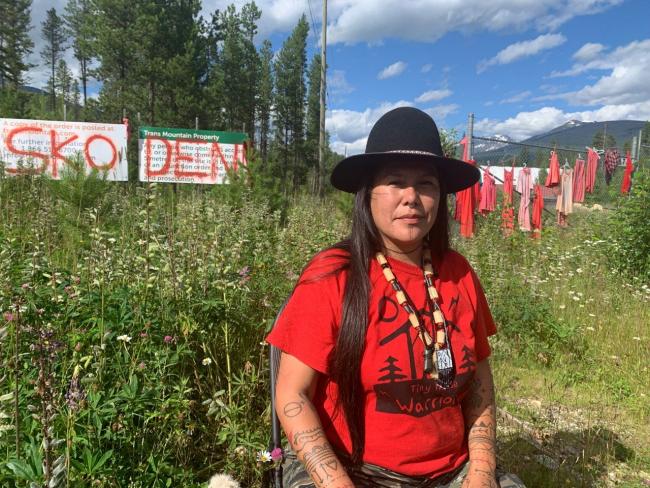
August 7th 2020
A minefield of racial divides, violence and human rights violations is about to explode in Blue River, B.C., over the expansion of Canada’s Trans Mountain pipeline (TMX).
On Saturday, July 25, tensions mounted in Blue River, B.C., a tiny community of just 260 people encircled by a backdrop of a stunning mountainous landscape along Highway 5.
It’s situated at the confluence of the Blue and North Thompson Rivers, where part of the TMX expansion is underway.
The land, like much of B.C., is unceded Indigenous territory.
Since 2017, a small group of Secwépemc land defenders called Tiny House Warriors have been occupying their traditional lands to oppose the pipeline expansion, citing a lack of free, prior and informed consent, and violence toward Indigenous women and girls associated with industrial construction.
Tension has been high for years, and it’s escalating rapidly. Over the last month, local townspeople have started holding weekly counter protest “sit-ins” outside the barricades of the Tiny House Warriors village because they want them to pack up and leave. Pipeline supporters want the jobs and money that come with the development.
But on July 25, they organized a bigger rally which included supporters of oil and gas who travelled to Blue River from Alberta to declare they’re sick of the opposition to the pipeline.
The Trans Mountain expansion will twin an existing pipeline over almost 1,000 kilometres, carrying heavy crude/bitumen from Alberta’s oilsands to the west coast of B.C. It will increase the current capacity of 300,000 barrels of oil per day to 890,000 barrels per day to export to worldwide markets.
The people that I spoke with at the pro-pipeline rally said they weren’t necessarily there because they had issues with the Tiny House Warriors protest, but they were concerned about the conduct of its leader, Kanahus Manuel.
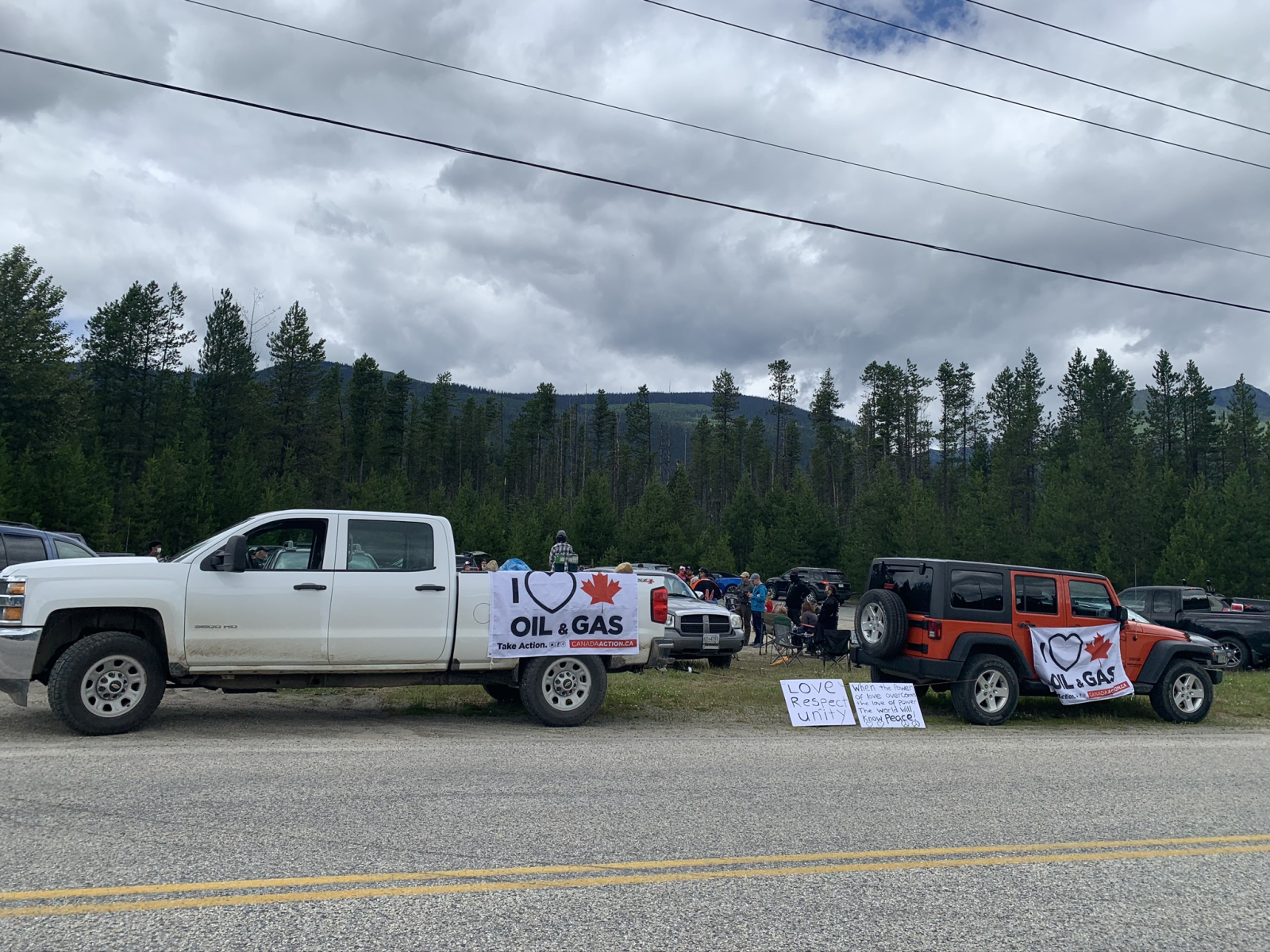
“I’m here because the [Tiny House Warriors] are disrespecting the people (who) live here,” said a man who came from Alberta with his wife, both proudly donning ‘I love Canadian oil and gas’ T-shirts. “Protest, but protest in a peaceful manner,” he said. “And [by] not bringing race into this whole thing.”
During our conversation, a tall, husky man with a grey moustache, wearing a black, leather baseball cap, sunglasses and a black leather vest with a Harley-Davidson symbol looked me over. His big, shiny motorcycle sat next to a couple other bikes, making their steeled presence known.
At the same time, a group of Indigenous land defenders stood across the road from the counter protestors and started to sing the Women's Warrior Song.
To me, it's a comforting, strong and spiritual song that helps lift my spirits when life gets tough. But that same song evokes a completely different response from pipeline supporters across the divide.
“Le le le le le le le le!” a pipeline supporter yelled in response to the women singing, mocking an Indigenous war cry.
I called out to him and asked why he did that.
The man attempted to take off, but I kept my camera on him.
“What did you just mean when you made that remark?” I asked.
“That was an East Indian remark, thank you,” he replied while he dodged away from view, adding defensively: “I’m half-East Indian, by the way.”
No one I spoke with knew the true history of the lands—which isn’t surprising, as real colonial history hasn’t been unveiled to mainstream society or taught in schools.
“You can do it [protests] the nice way, with kindness and love,” said a woman sporting an 'I love Canadian oil and gas' hoodie.
Her name was Patty. She was a grandmother in her 70s who had travelled there from Alberta.
I asked her: who makes rules about the way a protest ‘should’ happen? I mentioned that in the U.S., the brutal murder of George Floyd sparked mass protests that have occasionally spilled over into violence.
I reasoned with her that people are in the streets because they’re furious about injustice. And that even during the civil rights movement of the 1960s, the white community was upset with how Martin Luther King was leading resistance — in their eyes, he wasn’t doing things right back then either.
Did she know about the recent history of colonialism and violence inflicted upon Indigenous Peoples? The attempted genocide that’s ongoing, along with continual human rights violations?
A friend of hers interrupted me to tell me the Secwépemc didn’t own this land.
Patty tried to continue the conversation, saying: “I feel that they’re [Tiny House Warriors] being racist, when we’re all the same people. We, the whites, were once slaves.”
I informed her Indigenous Peoples in Canada do not have equality and face oppression in countless forms, but she told me that’s what she believes, in her heart, as she patted her chest.
It was the same with each person I talked to. Anytime I questioned them about Indigenous rights and title to lands, they shut down. They just wanted the Indigenous Warriors to hold “nicer” protests, they said, claiming that racism played no role in the conflict. Their beliefs were irreconcilable with the reality of oppression and land rights violations toward Indigenous Peoples.
The pro-oil townsfolk and supporters put emphasis on the ‘tone’ of the Indigenous land defenders' protest, which they wanted to see done on their terms.
Before that day, Tiny House Warriors and supporters expressed concerns for their safety because rumours swirled about who was coming to the counter rally. Was a biker gang coming to take them out? That was one of the rumours.
A few Indigenous land protectors from the Vancouver area travelled to Blue River to act as security in case anyone was targeted with violence.
Tiny House Warriors have every reason to be concerned. In April, two white men showed up at the camp and stole Kanahus’ truck. They rammed it into one of the five Tiny Homes. Kanahus is a mother, and her children are sometimes there.
According to the Star, “the men did not identify themselves but let her know they were supporters of the oil and gas industry.” The vehicles had Alberta licence plates, according to Kanahus.
She said that as soon as the men arrived on site, they started tearing down red dresses that were hanging to honour missing and murdered Indigenous women and girls.
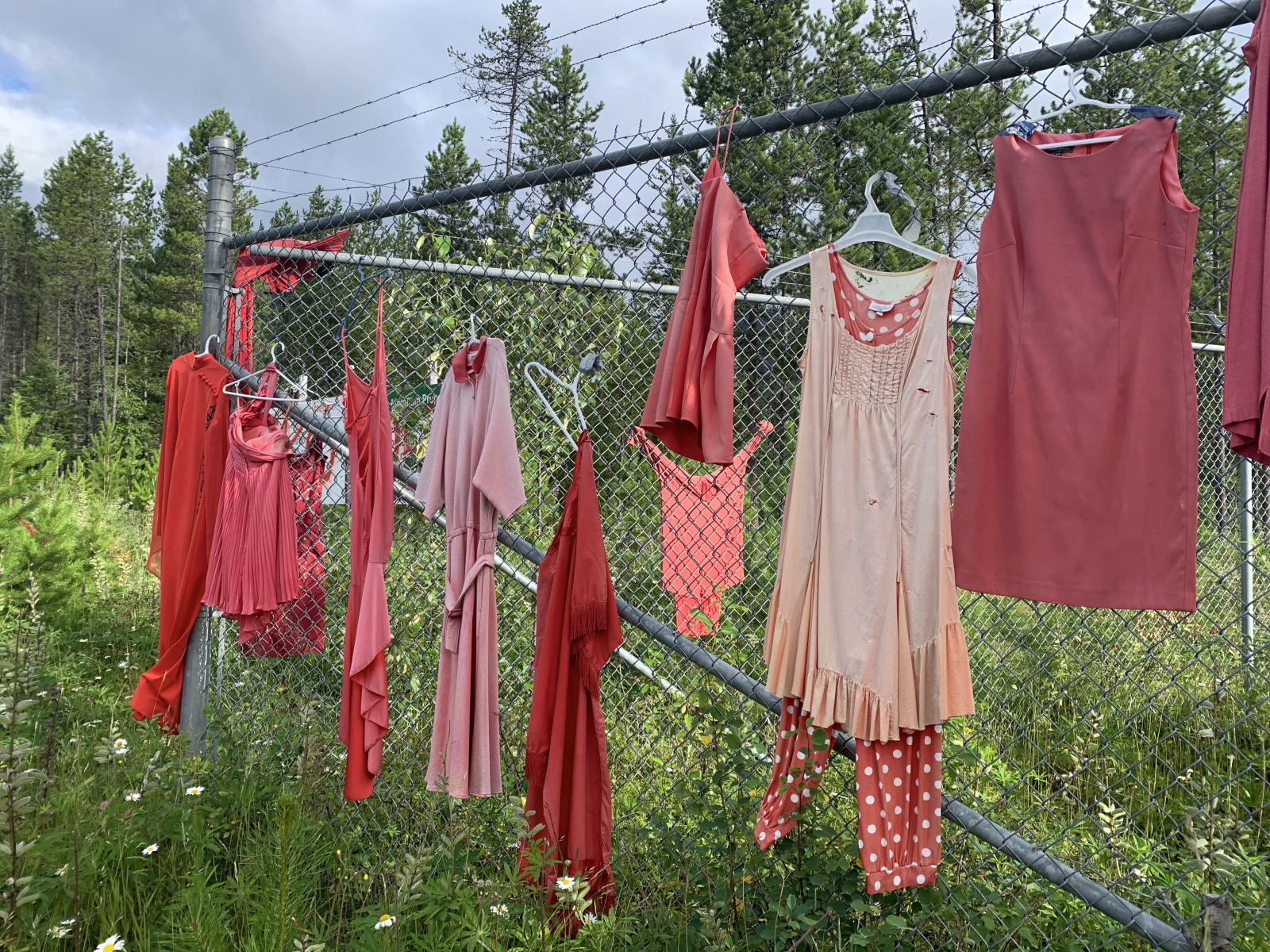
Photo by Brandi Morin of red dresses memorial to missing and murdered women
The camp is stalked by police on a regular basis, Kanahus said. It is droned, patrolled and surveilled. She’s been arrested too.
Kanahus Manuel is often painted in mainstream media as an anarchist, a rebel and a terrorist. But to many Indigenous land defenders, she’s a hero, descended from a long line of Indigenous leaders.
Her late father was revered Indigenous rights leader and author Arthur Manuel. His father, George Manuel, is known as a great Indigenous leader in Canada and around the world. George was the founding president of the World Council of Indigenous Peoples and was instrumental in the creation of the United Nations Declaration on the Rights of Indigenous Peoples.
Kanahus’ face is soft, but defined with fierce determination and a ‘don’t-mess-with-me’ demeanour.
She knows who she is; she knows her rights as an Indigenous woman. She leads this movement of Indigenous sovereignty, rights and self-determination. Here, as elsewhere in the world, women are the ones leading the battle to protect their lands and waters. Everywhere you look on the front lines of environmental and Indigenous justice, you’ll find matriarchs fighting to protect their land for the next generation.
The impacts to the environment from resource development go hand in hand with impacts against Indigenous women and girls. Canada is in the midst of a genocidal crisis with missing and murdered Indigenous women and girls (MMIWG).
The National Inquiry into MMIWG cites the resource extraction industry as playing a role in the crisis.
One impact is ‘man camps,’ which house hundreds, sometimes thousands, of mostly male workers in remote areas working on construction projects. This threatens the safety of women, many of them Indigenous, leaving them vulnerable to violence and rape.
Dozens of red dresses were hung on the chain link fence of the TMX pump station to signify MMIWG, along with a banner with handwritten messages of rape and violence directed at industry.
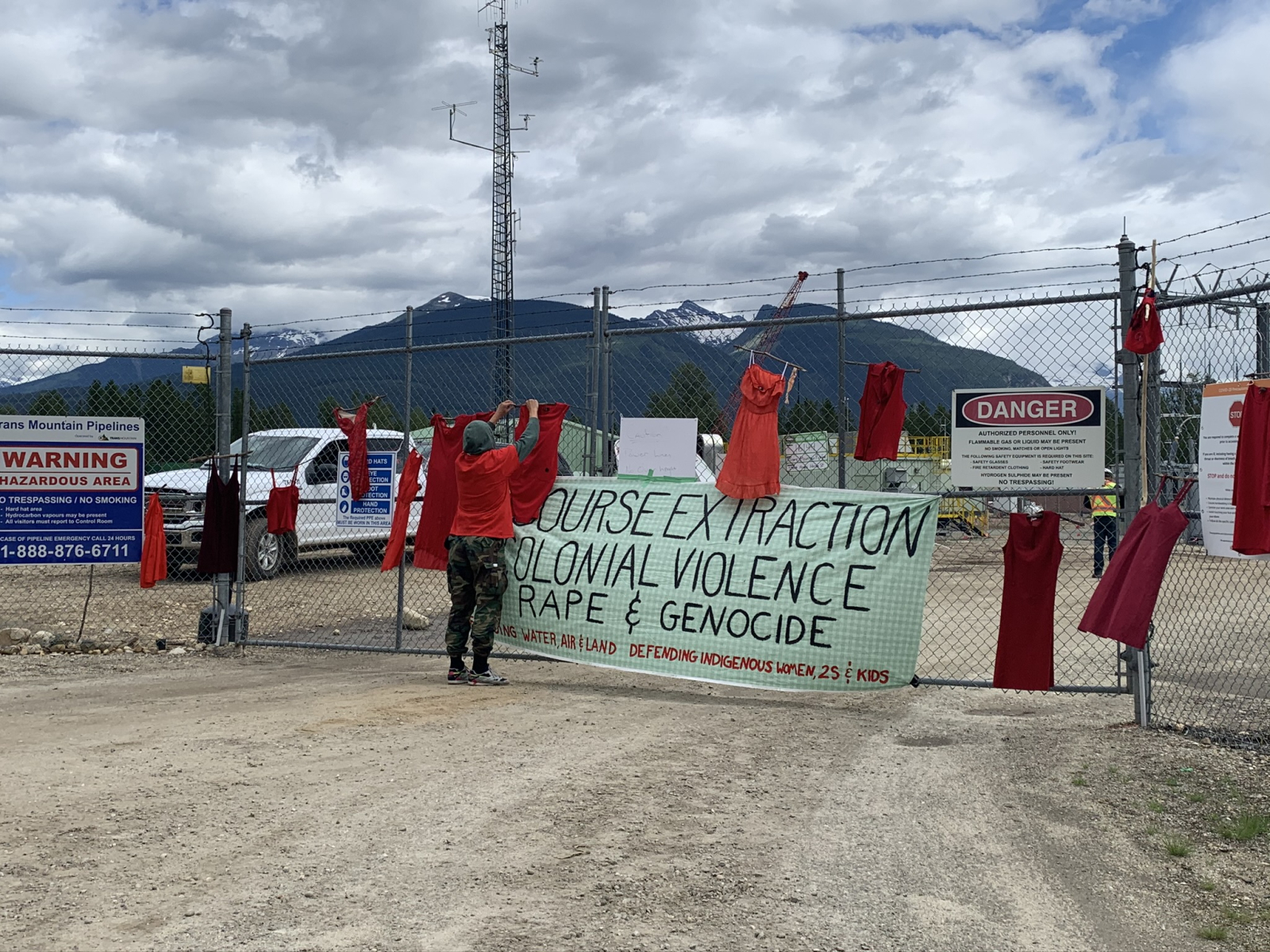
Red dresses at the TMX gate. Photo by Brandi Morin
While the pipeline supporters insist they’re fighting for jobs and economic prosperity, land defenders here feel they’re fighting for their lives. A young woman, dressed in full camouflage gear, a camouflaged hat, face scarf and combat boots, broke down in tears before singing a song for missing and murdered Indigenous women and girls at a ceremony held across from the TMX pump station that day.
The Indigenous Warriors here dress in camouflage gear as if standing as guardians to shield Kanahus and the others. One held a Mohawk warrior flag billowing in the wind. The flag symbolizes Indigenous strength, resilience and resistance for them.
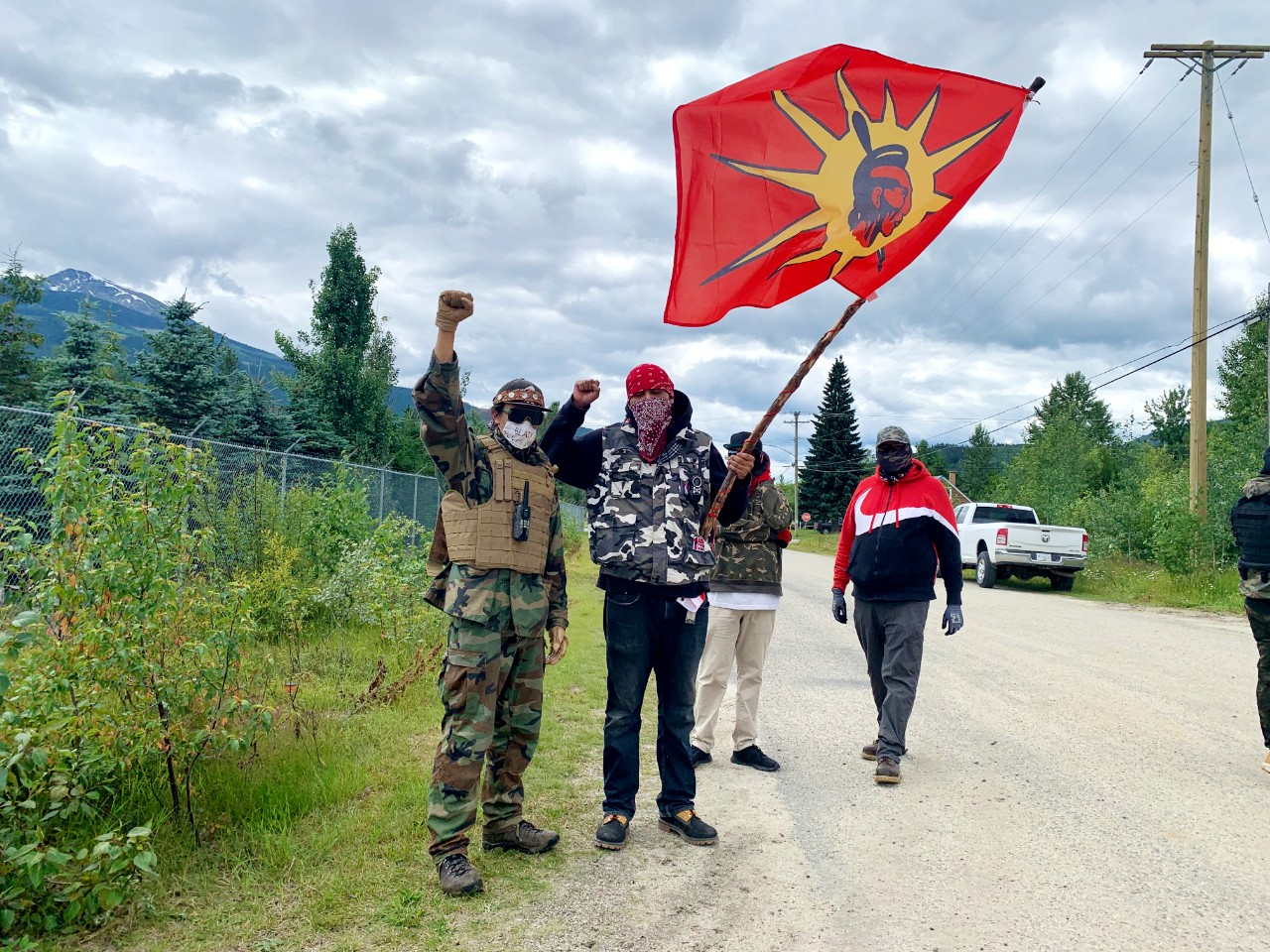
But not all Indigenous people here are united against the pipeline expansion.
There’s division between Indian Act leadership from nearby bands and Secwépemc traditional land title holders over who has inherent title.
The elected chiefs of both the Simpcw First Nation and Tk’emlúps te Secwépemc say they gave their free, prior and informed consent to the pipeline expansion in 2017.
Tiny House Warriors and supporters dispute Indian Act-elected leadership and its claim to make decisions on territories located outside of reserve boundaries.
Kanahus says Canada is intentionally bypassing its responsibility to free, prior and informed consent.
“They (Canada) are meddling in internal affairs amongst our nation,” stated Kanahus, who explained the title and inherent rights to the territory are held collectively by Secwépemc.
Neskonlith te Secwépemc Chief Judy Wilson was on hand to support the ceremonies held by Secwépemc Elders to offer prayers to Mother Earth, water and the Indigenous land defenders in the nations who protect the Sacred.
“Because our nation didn’t surrender, cede or sell our title. It’s still held collectively by the people who are title holders,” said Chief Wilson.
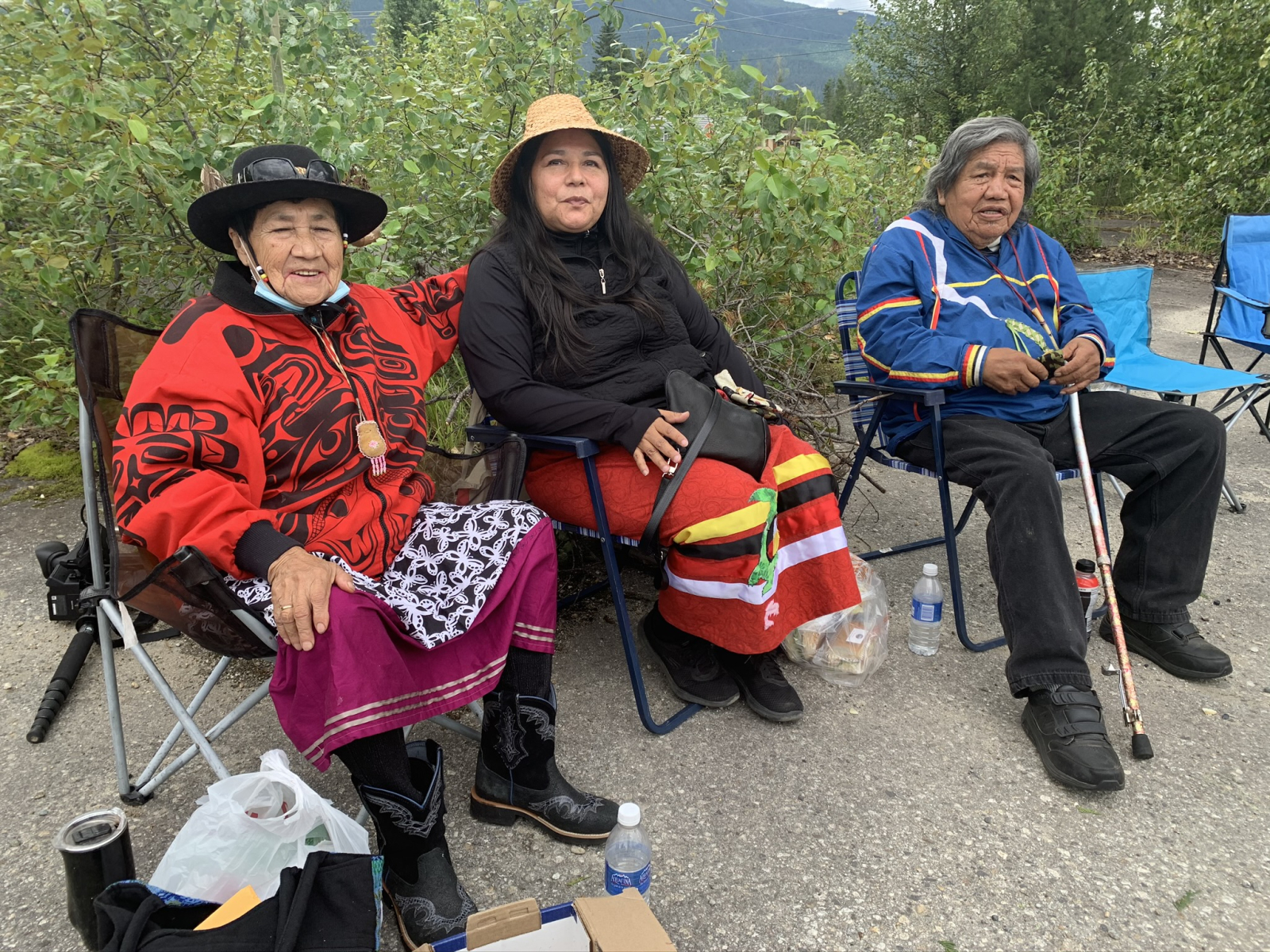
Chief Wilson expressed concerns about how corporate rights and interests are more protected, and about the disregard for consent of the proper title holders in Canada.
The pipeline expansion is owned by Canada, bought in 2018 for $4.5 billion in an eleventh-hour move to save the pipeline after its former owner, Kinder Morgan, threatened to pull out due to concerns of opposition from British Columbia. Finance Minister Bill Morneau said the project would “deliver significant economic benefit” and added that Canada would “put that economic benefit back into the environment.”
Tiny House Warriors and relatives of MMIWG wonder when more money will be invested to help the crisis and other ailments affecting Indigenous Peoples, such as a lack of access to clean drinking water.
“People don’t just get to reap the benefits of living in this world when our people are stuck on reservations in some of the poorest situations geographically, no good growing land and no good water,” Kanahus said.
“But a settler community can have the most pristine water in the world? Then when Native people come here and want to enjoy the same wealth and benefits on our own territories, they bring violence to us to chase us back to the Indian reserve?”
She said a culture of “white supremacy” fuelled the removal of Indigenous Peoples from their land, and that it was time for this system to end, just like slavery was ended in the U.S.
“When they [the U.S.] were abolishing slavery, people thought [owning slaves] was legal, and it was!"
Kanahus believes reconciliation is a facade without the return of land to Indigenous Peoples.
"There can only be reconciliation with land back. And that will never happen,” she said.
“We know that it’s going to come to fighting for our land. We’ve exhausted all of our remedies. The only way we’re going to get any type of justice is if we go outside of the country to our international allies.”
Chief Judy Wilson wrote an email to Amnesty International Canada secretary general Alex Neve days before the counter protests to express concerns for the safety of the land defenders. Neve, in turn, wrote to the B.C. RCMP deputy commissioner, chief superintendent and assistant commissioner, urging that the RCMP play a peacekeeping role, and to remind them to uphold Indigenous rights.
However, many are distrustful of the policing system, given historical and current police violence, racism, high incarceration rates and criminalization of Indigenous Peoples. They find it hard to trust the police to do their job of serving and protecting, especially after seeing RCMP arrest and remove Wet’suwet’en Peoples from their traditional lands in February.
“Whenever our women, youth, elders stand up for the land and water under our inherent responsibilities to care for Mother Earth and teachings from Creator, anywhere in the country, people are criticized and there’s perpetual violence against us from the police, governments or corporations who are trying to push their way through our territories for extractive resources. We are put in jail, charged,” said Chief Wilson.
“That’s relaying that corporations have more rights than our people. When our people don’t consent and say no, we are circumvented to criminalization.”
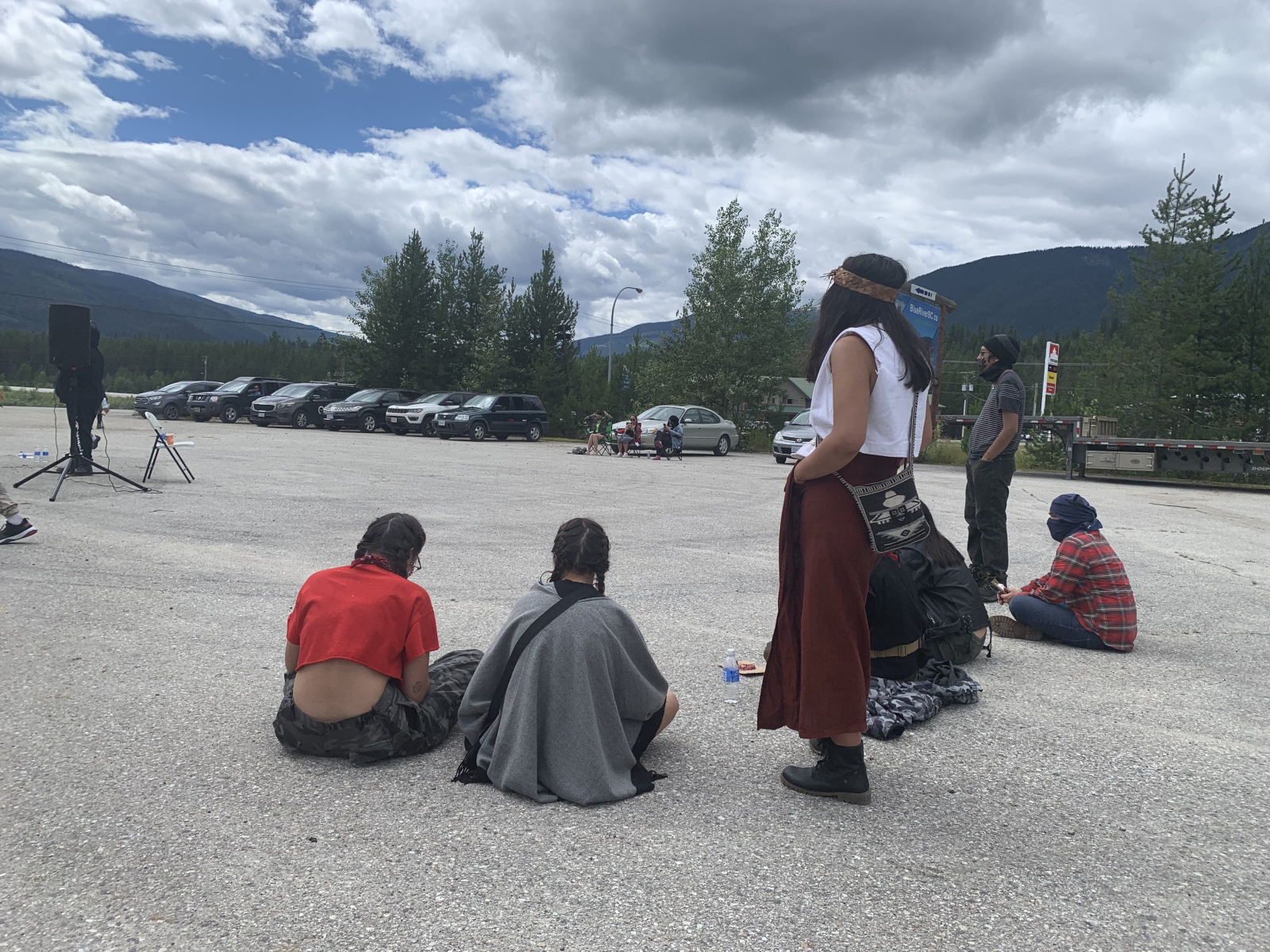
Photograph by Brandi Morin of land defenders at a ceremony supporting Tiny House Warriors in Blue River July 25
Despite initial concerns of violence, events wrapped up before 5 p.m. Both dodged violent encounters with each other.
I was across the road later that day near my hotel, when I noticed a white man aggressively ripping down items in the trees. They were next to the parking lot where the ceremony was held earlier and I realized he was ripping down the red dresses left behind.
I drove over quickly. I’m all of 5'1", and this was an enraged man displaying violent behaviour. It was still daylight, there were people within sight that could see me, I reasoned to myself.
When I arrived, I turned my Periscope back on to begin livestreaming. The man was ripping down the red dresses — symbols of a national tragedy of the murders and disappearances of our women.
It scared me. Then, I felt angry.
“I’m ripping out the garbage from out of the trees,” he replied.
I was stunned. It was so open. So blatant.
The TMX workers could see him through the gate. Nobody seemed to care.
I told him those were red dresses, and that they’re not garbage.
He cut me off with an “F you” and a middle finger, then walked away.
B.C. Premier John Horgan told locals to call the RCMP if they have concerns with the Tiny House Warriors. For now, he’s washed his hands of the issue. I reached out to the Province for comment on this, but didn't receive a statement before publication.
The Canadian government owns TMX, so we know where it stands.
In my view, it’s not a matter of if, it’s a matter of when the two sides collide and the result could very well end up in violence similar to the Oka crisis of 1990.
If this happens, the Tiny House Warriors will likely bear the brunt of violence.
Meanwhile, the townspeople are taking action of their own with a one-track mind of going to work for the pipeline.
There’s a war stirring up here, and it’s a landmine.
Watch closely in the coming days.
And see if you’re comfortable knowing the injustice of what’s happening and thinking of how to explain the situation to your children and grandchildren one day.
Will you be able to do it in a “nice” way?
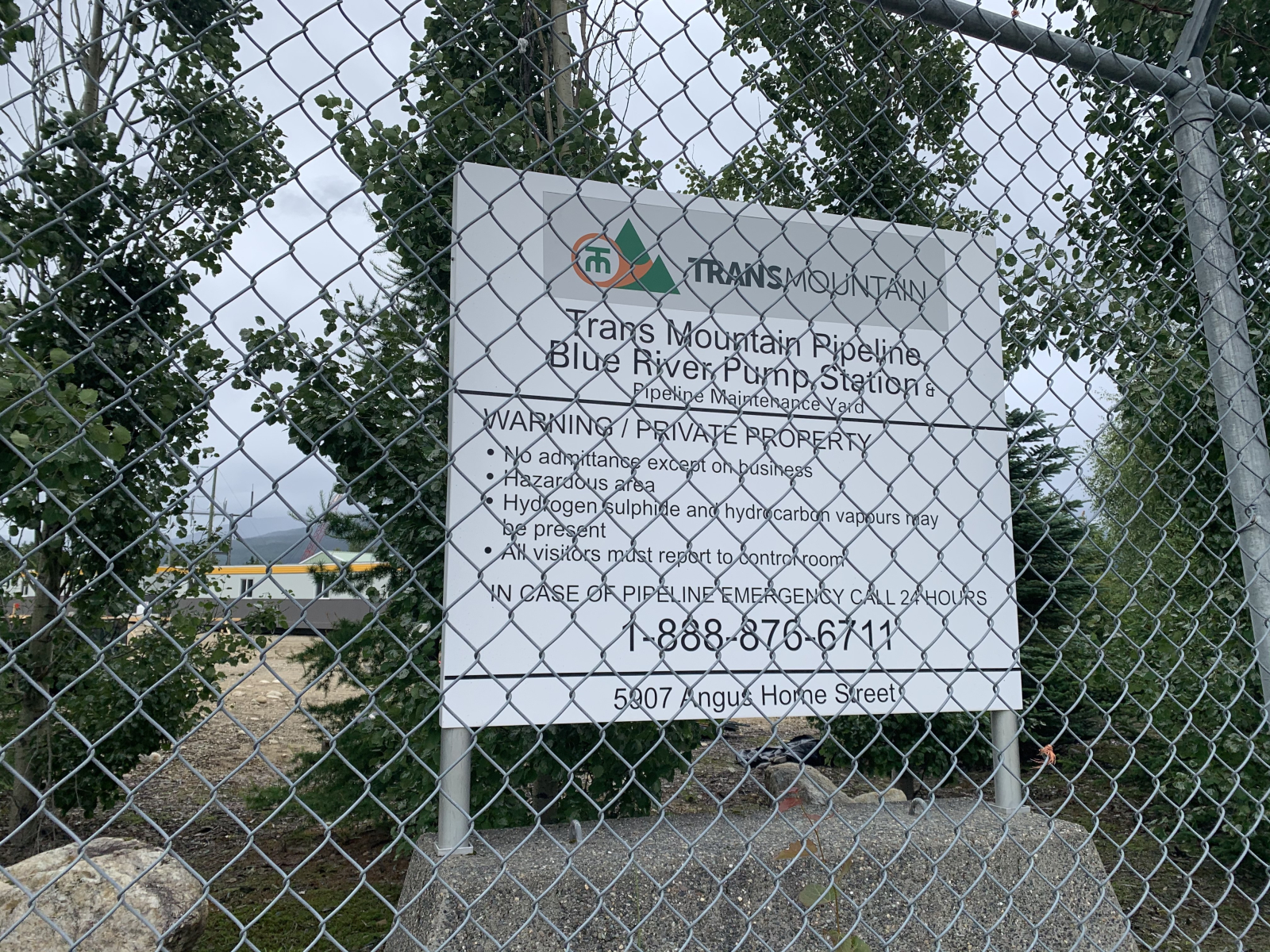
Trans Mountain Pipeline sign in Blue River, photograph by Brandi Morin
[Top photo: Photo of Kanahus Manuel of the Secwépemc Nation at the Tiny House Warriors demonstration near Blue River, B.C. by Brandi Morin]